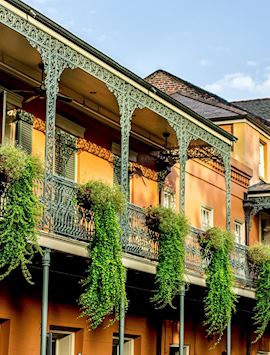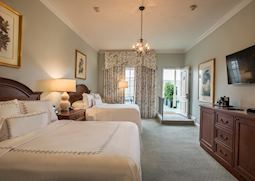Jump to:
Repeatedly passed between the Spanish and the French until joining the United States in 1803, New Orleans’ chequered history has accumulated a wide variety of cultures, nationalities and traditions. The result is a city with an altogether different atmosphere to the rest of the country, where the pace of life is relaxed and reminders of the past are everywhere you go.
The historic French Quarter sports colonial-era architecture and sophisticated bars, while the dulcet tones of saxophones fill the air in the jazz capital of Frenchman Street. Head a little further out to discover swamp wildlife, or learn about the area’s slave history by touring an original 19th-century plantation home.
USA specialist AliceWhat draws me to New Orleans is its exciting mix of cultures, ever-evolving music scene and food that can’t be replicated anywhere else. While not as polished as other US cities, its grittiness is part of the charm.
Things to see and do in New Orleans
Explore the historic French Quarter
The oldest part of the city, the French Quarter dates back to New Orleans' very beginnings in 1718. It has been designated a National Historic Landmark by the US government. Strolling through the streets, you’ll pass 18th and 19th-century buildings, their cast-iron balconies and pastel walls designed by early Spanish settlers. Take a walking tour through the quarter with a local guide to deepen your knowledge of its past and its Creole culture.
The district is known for its many lively bars and restaurants. A cocktail tour takes you around the bars and speakeasies that defied the prohibition era. You can sample a variety of concoctions, including the city’s official Cognac-based cocktail, the Sazerac.
Soak up jazz culture on Frenchmen Street
A vibrant music scene strikes up and brings New Orleans to life each evening. The birthplace of jazz, you’ll find saxophonists on every corner, tuneful rhythms seeping out of independent bars and intimate live music venues nurturing new talent.
Frenchmen Street, with its relaxed jazz clubs and thriving art scene, offers an authentic Big Easy experience. By day, you can sit in jazz cafés soaking up the laid-back atmosphere. The evening brings opportunities to flit between the many characterful bars, where live musicians put on world-class performances, and to wander through the outdoor night market, where local artisans sell artwork and handmade crafts.
Stroll through the Garden District
The affluent Garden District was created in the 19th century as a settlement for wealthy Americans attracted to New Orleans’ prosperity. Preferring not to mingle with the French Quarter’s Creole population, they built opulent antebellum mansions. Today, you can stroll or take a cycle tour past some of these well-preserved homes and their large, immaculate gardens that earned the district its name.
At the intersection of Prytania Street and Washington Avenue are shops, cafés and the Lafayette Cemetery No.1. This historic cemetery features above-ground graves in elegant, whitewashed vaults. The style originates from the city’s French and Spanish heritage, and many descendants of the dead still maintain their family vaults.
Spot wildlife on an airboat swamp tour
 Set on the east and west banks of the Mississippi River, just south of Lake Pontchartrain, New Orleans is close to Louisiana’s swamps and bayous. These large wetlands provide a habitat for a variety of wildlife species, most notably alligators. You can take an airboat tour with a local guide to learn about the plants and animals of this water-world ecosystem.
Set on the east and west banks of the Mississippi River, just south of Lake Pontchartrain, New Orleans is close to Louisiana’s swamps and bayous. These large wetlands provide a habitat for a variety of wildlife species, most notably alligators. You can take an airboat tour with a local guide to learn about the plants and animals of this water-world ecosystem.
Gliding through the water, you’ll cross overgrown swamps and peaceful bayous lined with moss-draped cypress trees. Look out for basking alligators, which lie perfectly still other than for the occasional eye movement. You may also spot birdlife such as egrets, brown pelicans, herons and ibis, as well as turtles, snakes and coypu (river rats).
Tour Louisiana’s plantation homes
Some of the darkest days in American history are laid bare by visiting original 18th and 19th-century plantation homes. The grandeur of these antebellum mansions, with their large rooms and extensive manicured grounds, gives an indication of the wealthy lifestyles of the sugar and cotton plantation owners of the time.
Mansions close to New Orleans include Oak Alley which dates back to 1839 and has a distinctive avenue lined with 250-year-old oak trees, and Laura Plantation, built in 1804. Here, you can pay a poignant visit to the property’s slave quarters, which have been restored in keeping with the real-life memoirs of its former resident, Laura Locoul Gore.
Learn to cook Creole and Cajun food
The American South’s hearty cuisine is influenced by centuries of Spanish, French, Caribbean and West African inhabitants, and the food found on the streets of New Orleans reflects its multicultural roots.
The New Orleans School of Cooking offers courses and demonstrations that teach you the techniques of Creole and Cajun cooking. You can watch an expert demonstrate how to make dishes such as jambalaya, crawfish etouffee and gumbo. Alternatively, join a hands-on session where you’ll prepare ingredients under the guidance of an experienced chef and then eat your authentic Louisiana meal, washed down with iced tea or a local beer.
Best time to visit New Orleans
Holidays to New Orleans are best between December and May, when temperatures are warm but not too hot and humid. April and May are the ideal months for visiting; days are warm and dry, and different events take place in the city. Between June and August, conditions can be very sticky, with occasional thunderstorms breaking the heat. The hurricane season runs between June and November.
Festivals, events and seasonal reasons to visit
- Mardi Gras is New Orleans’ biggest and best-known festival, taking place each year for two weeks over Easter. Vibrantly clothed dancers and themed floats parade through the streets, watched by excited crowds. The biggest parade is saved for Mardi Gras Day on the Tuesday before Ash Wednesday.
- Running for ten days between April and May, the annual New Orleans Jazz Festival celebrates the music and culture of the city and Louisiana as a whole. It features live music, local food and traditional crafts.
who's been there

Start planning your tailor-made trip to New Orleans by contacting one of our American South specialists
-
01993 838 92501993 838 864
- Make an enquiry
Suggested itineraries featuring New Orleans
Our itineraries will give you suggestions for what is possible when you travel in New Orleans, and they showcase routes we know work particularly well. Treat them as inspiration, because your trip will be created uniquely by one of our specialists.
Places near New Orleans
- Baton Rouge 75 miles away
- Lafayette 119 miles away
- Natchez 137 miles away
- Vicksburg 173 miles away
- Panama City Beach 256 miles away
- Montgomery 279 miles away
- Clarksdale 296 miles away
Photos of New Orleans
Accommodation choices for New Orleans
We've selected a range of accommodation options for when you visit New Orleans. Our choices usually come recommended for their character, facilities and service or location. Our specialists always aim to suggest properties that match your preferences.
-
![Double Double Sun Deck Room at Bienville House]()
Bienville House
New Orleans -
![Pontchartrain Hotel in the Garden District]()
Pontchartrain Hotel
New Orleans -
![Hotel Monteleone]()
Hotel Monteleone
New Orleans -
![Rooftop pool at Omni Royal Orleans]()
Omni Royal Orleans
New Orleans
Ideas for experiencing New Orleans
Our specialists seek out authentic ways to get to know the places that could feature in your trip. These activities reflect some of the experiences they've most enjoyed while visiting New Orleans, and which use the best local guides.
-
French Quarter Walking Tour ![French Quarter, New Orleans]()
French Quarter Walking Tour
French Quarter Walking Tour
Let your own 'local expert' unravel the mysteries of one of America's oldest and most unique living neighbourhoods.
View details







